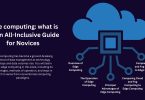Cloud Computing:
Cloud computing employs a client-server architecture to deliver computing resources such as servers, storage, databases and software through the Internet, offering flexible pricing options based on actual use.
The popularity of cloud computing originates from its multiple benefits, including cost savings, enhanced productivity, improved efficiency, superior performance, data backups, disaster recovery capabilities and heightened security.
Grid Computing:
Grid computing which is also known as “distributed computing,” connects multiple computing resources such as PCs, workstations, servers and storage elements; and facilitates access to these resources.
Grid computing offers notable advantages, such as heightened user productivity through seamless resource accessibility and high or faster completion of tasks.
In this article, we will explore the distinctions between cloud computing and grid computing.
Cloud Computing Vs Grid Computing:
Cloud Computing
- Cloud computing follows a client-server computing architecture.
- Scalability is high in cloud computing, enabling easy expansion of resources.
- Cloud computing is more flexible than grid computing.
- Clouds operate as centralized management systems.
- Infrastructure providers own and manage the cloud servers.
- Cloud computing encompasses services like Infrastructure as a Service (IaaS), Platform as a Service (PaaS) and Software as a Service (SaaS).
- Cloud computing is oriented to provide services to users.
- Access to cloud computing is achieved through standard web protocols.
Grid Computing
- Grid computing employs a distributed computing architecture.
- Scalability in grid computing is considered typical or average.
- Grid computing offers less flexibility in comparison to cloud computing.
- Grids operate as decentralized management systems.
- Organizations own and manage the grids in grid computing.
- Grid computing utilizes systems such as distributed computing, distributed information and distributed pervasive technologies.
- The main focus of grid computing is on applications and their specific requirements.
- Access to grid computing is facilitated through grid middleware.
Choosing the Best Strategy for Your Organization’s Needs:
Organizations can choose the best strategy for their particular needs by staying aware of the differences between these two computing platforms. Businesses are able to utilize these technologies to increase productivity, efficiency and total computing capabilities; whether they choose grid computing’s application specificity or the adaptability of cloud computing.
Conclusion
The delivery of computing resources and system management are managed to handle differently by cloud computing and grid computing. While cloud computing uses a client-server architecture with centralized management by infrastructure providers, grid computing employs a distributed design that enables organizations to own and administer their grids.








